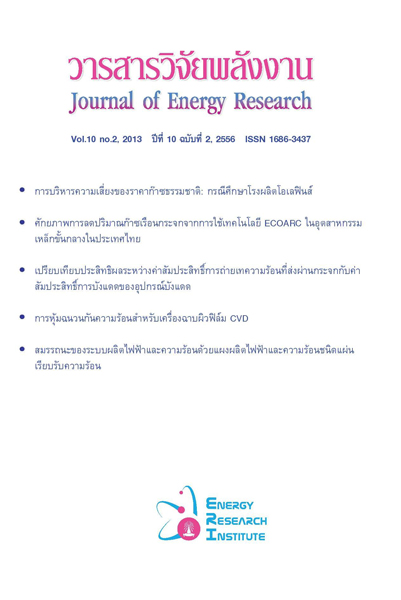การบริหารความเสี่ยงของราคาก๊าซธรรมชาติ: กรณีศึกษาโรงผลิตโอเลฟินส์
Main Article Content
Abstract
การศึกษานี้มีวัตถุประสงค์เพื่อศึกษาการประยุกต์ใช้ตราสารอนุพันธ์ในการจัดการความเสี่ยงและความผันผวนด้านราคาก๊าซธรรมชาติที่ใช้เป็นเชื้อเพลิงสำหรับโรงผลิตโอเลฟินส์ในช่วงปี 2554-2555 โดยทำการศึกษาด้านการตลาดและความสัมพันธ์ระหว่างราคาน้ำมันเตาที่ใช้อ้างอิงในสูตรราคาก๊าซธรรมชาติ SFO 180 cst, 2% sulfur และราคาน้ำมันเตา HSFO 180 cst, 3.5% sulfur ที่มีการซื้อขายตราสารอนุพันธ์ รวมถึงการประยุกต์ใช้ตราสารอนุพันธ์เพื่อบริหารความเสี่ยงราคาก๊าซธรรมชาติ โดยทำการศึกษาตราสารอนุพันธ์ 3 ประเภทได้แก่ สัญญาออปชั่นที่มีสิทธิซื้อ (Call option) สัญญาออปชั่นที่มีสิทธิขาย (Put option) และสัญญาสวอป (Swap)
ผลการศึกษาพบว่าการบริหารความเสี่ยงของราคาก๊าซธรรมชาตินั้นเป็นการบริหารความเสี่ยงแบบ Cross Hedge ที่ต้องทำบนราคาน้ำมันเตา HSFO 180 cst, 3.5% sulfur แทนที่ราคาน้ำมันเตา SFO 180 cst, 2% sulfur ตามโครงสร้างราคาก๊าซธรรมชาติที่มีข้อจำกัดของสภาพคล่องในตลาดตราสารอนุพันธ์ และการประยุกต์ใช้ตราสารอนุพันธ์ในสถานะซื้อสัญญาออปชั่นที่มีสิทธิซื้อ (Long call) นั้นไม่สามารถลดความผันผวนราคาและมูลค่าความเสี่ยงของก๊าซธรรมชาติ ในขณะที่การประยุกต์ใช้ตราสารอนุพันธ์ในสถานะขายสัญญาออปชั่นที่มีสิทธิขาย (Short put) และสัญญาสวอป (Swap) สามารถลดความผันผวนราคาและมูลค่าความเสี่ยงของก๊าซธรรมชาติลงได้
RISK MANAGEMENT OF NATURAL GAS PRICE: A CASE STUDY OF OLEFINS CRAKCER
Suthada Suwinthawong1 and Thitisak Boonpramote2
1 Energy Technology and Management (Interdisciplinary Program) Graduate School. Chulalongkorn University
2Department of Mining and Petroleum Engineering, Faculty of Engineering, Chulalongkorn University
Olefins cracker faces with not only the price volatility of raw materials and products, but the volatility of fuel cost. Hence, two main purposes of this study are 1) to apply financial derivatives as risk management tool to manage the volatility and price risk of natural gas using as fuel in olefins cracker during year 2011-2012 by studying fuel oil market and price relationship between fuel oil SFO 180 cst, 2% sulfur stated in natural gas price formula and fuel oil HSFO 180 cst, 3.5% using in financial derivatives market, and 2) to recommend hedging strategies and applications of three types of derivatives instrument: Call option, Put option, and Swap.
The outcome of this research suggests that risk management of natural gas price should be approached by cross hedging strategy in which fuel oil HSFO 180 cst, 3.5% sulfur is being hedged instead of fuel oil SFO 180 cst, 2% sulfur as stated in natural gas price formula. The findings reveal that hedging natural gas price with Long call option does not help to reduce price volatility (Standard Deviation) and Value at Risk (VaR). Hedging natural gas price with Short put option and Swap, however, help to reduce Standard Deviation and VaR results.

